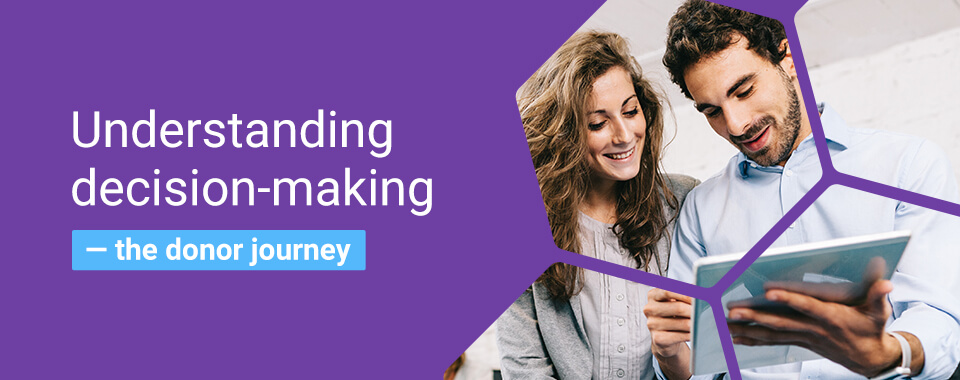Mar 18, 2022
Understanding decision-making – the donor journey


When donors decide to give to a nonprofit, they must go through the donor journey and develop a meaningful connection to a cause. If you want to gain more support and see your donations rise, it’s important to understand both why donors give and how you can make it easier for them to get involved with your nonprofit.
Once they’ve browsed through your content, they’ll want to see how they can support your mission. Keep reading to learn the most effective ways to help donors decide to give and encourage recurring donations.
The stages of the donor journey
There are four primary stages of the donor journey that determine your nonprofit’s ability to attain and retain loyal supporters. Out of the four stages, we will focus on the third stage of the donor journey, decision-making. This will help you better understand what drives donors to choose to support a nonprofit.
1. Awareness
Awareness is the first stage of the donor journey and relates to how well-known your organization is. If people aren’t aware of your nonprofit, gaining donors and establishing connections with supporters might be more challenging. This means you need to raise awareness about your mission and cause through your website content and other means of outreach. If you can promote your nonprofit, you have a better chance of engaging donors looking to give to a cause like yours.
2. Consideration
After donors become aware of your nonprofit, they may browse through your website and other content for information about your values and purpose to determine if they want to support you or not. In this stage, it’s essential to be transparent with your audience and share what makes your organization stand out. Try to find ways to get donors to connect to efforts and encourage them to become a part of your mission.
3. Decision-making
At this stage, your donors have collected enough information about your nonprofit to decide whether they will or won’t give to your cause. This phase is critical. You want to ensure your donor remains interested and feels that your cause connects with their expectations and needs. Once they decide to become support your mission, donors are more likely to spread the word about your campaigns and fundraisers. It’s crucial to keep them involved.
4. Evangelizing
The final stage occurs when your donor gives their full support to your nonprofit by promoting your work and upcoming events. As your donors spend more time with your nonprofit, they will also get to share their own positive experiences. They may even give testimonials on your website and other platforms to attract more awareness and support.
Make it easy to donate
When your donors come across the decision-making phase of the donor journey, their primary choice is whether or not they want to give money to your cause. It’s important to make their donation process accessible and manageable. If a donor can’t find your donation button after navigating your website for a few minutes, they may become frustrated and click away.
Here’s a quick checklist to keep in mind when designing your donation pages or buttons for your website:
- Check that your button is large and bright so donors can easily find it.
- Place your donation button on every page of your website.
- Embed your donation button into your website to prevent donors from getting redirected somewhere else.
- Use familiar colors, logos, and branding so everything feels consistent.
- Optimize your donation button for mobile users and include a text-to-donate option.
- Make your donation process simple so donors don’t have to fill out too many steps.

Why do people donate?
Another element to understand about the donor decision-making phase of the donor journey is learning why people like to donate in the first place. What drives them to give to organizations and encourages them to provide continued support? Here are some common reasons people contribute. Keep them in mind as you learn how to approach this step of the donor journey:
- They want to spread generosity. Many people feel good after they donate to a worthy cause. Giving can positively impact one’s health because of the release of dopamine and other “feel-good” chemicals.
- They believe in and trust your nonprofit. Donors will likely give to a nonprofit that values trust and transparency. It’s important to prove yourself worthy of their commitment.
- They know their donation will have an impact. Sharing your program outcomes is an excellent way for donors to know that their contribution makes a real difference. Take the time to make them feel accomplished and empowered.
- They connect to your mission. A donor may feel inclined to give to your cause because they can relate to it or know someone who has benefitted from your impact.
- They want to associate with your brand. The more awareness and support your nonprofit gains through personal stories, the more donors will want to connect with you and proudly represent the work you do.
People may also donate to your cause because they know someone who volunteers within your nonprofit and advocates for your mission. Existing donors also help with this. They spread the word and encourage friends and family to donate to a worthy cause.
How to help potential donors make a decision
There are many ways you can inspire prospective donors to give to your organization. While making it easy for them to donate is the first step, you can delve even further and use techniques that reach a broad, diverse audience. From recurring donors to people looking to become a part of a nonprofit for the first time, you can help make their donation experience seamless with these strategies that encourage donations.
Provide suggested options
Give donors different donation amount options and create different tiers for each dollar amount that shows how their support will help your nonprofit. You can also include an option for recurring gifts so donors can give automatically instead of manually inputting their information every few weeks.
Use effective CTAs
Crafting a meaningful, important call-to-action (CTA) as a part of your emails, newsletters, or website is another way to drive home your key messages and encourage your audience to become a part of your nonprofit. These messages will make your donors feel inspired to participate in your work and contribute to a positive impact on their community.
Let them know why they matter
Donating is personal. Create donor-centric content that appeals to the personal connection they feel when they think of your nonprofit. Always let your donors know how important they are to your organization and how they help you continue your mission with their funding and support.
Show them exactly how you’re using their gift
Many donors may be cautious of donating because they don’t know how their gift is used. It’s a good idea to post videos, infographics, reports, and any other means of showing your donors where their money goes within your organization. The more information and transparency you can provide, the more your donors will feel confident they can trust you to do meaningful work in the community.

Make donating easy with GiveSmart
Once you’ve secured your donors’ support after their donor journey, the donation process must be engaging and accessible. With GiveSmart, your nonprofit can benefit from several software solutions that allow you to manage your donations, donor data, and many other elements in one integrated platform. You can analyze the data and insights you collect and apply them to your organization’s strategies to improve your methods for success.
Our features will simplify your processes, help you expand your reach, and make it easy to conduct online fundraisers — so your donors can support you on any device at any time. Request a demo today to see how our solutions can help you attract and retain more support through the donor journey.
Related



